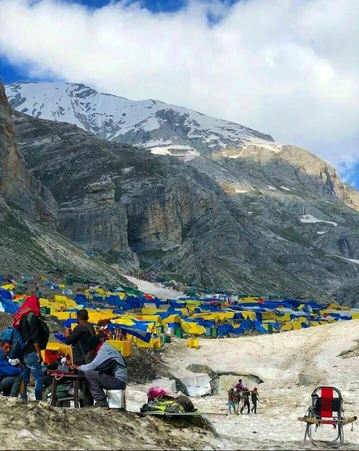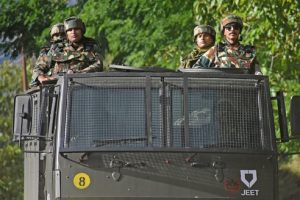Lt Gen Dr. Subrata Saha (retd)
The Amarnath shrine, located to the north of Pahalgam in Kashmir, and south of the Zojila Pass, gateway to Ladakh, is believed to be the holy spot where Lord Shiva took Samadhi (deep meditative contemplation leading to higher consciousness), before narrating the story of eternity and immortality to Goddess Parvati, hence the name Amarnath. The remote mountainous cave, tucked away from living beings, is at an altitude of 5,486 metres (13,000 ft).
According to legend, as Lord Shiva undertook the ascent, he progressively detached himself from the world around him. He left his Nandi (Sacred Bull) at Pahalgam (Bail gaon); at Chandanwari, he released the Moon from his Jata (hair); at the banks of Lake Sheshnag, he released the snakes; and at Mahagunas Parvat (Mahaganesh Hill), he chose to leave his son Ganesha behind. Finally, at Panjtarni, he detached himself from the five elements of Nature – Earth, Water, Air, Fire and Sky.
Having foregone all worldly attachments, Lord Shiva took Samadhi at the Amarnath Cave.
There are stories on the discovery of the Holy Cave. A shepherd named Buta Malik of Batkote village near Pahalgam, strayed into the area while grazing his sheep, where a Sadhu gave him a sack of coal. Upon reaching home, he discovered that the sack, in fact, contained gold. Overjoyed with his discovery, Buta Malik rushed back to thank the Sadhu, only to discover the cave at their meeting site. Yet another mythological legend has it that when Kashyap Rishi drained the water out of Kashmir valley, which was a vast lake, the cave and the lingam were discovered by Bhrigu Rishi.
Shri Amarnathji Yatra – mammoth administrative and security exercise
Legends arouse human imagination and the desire to seek blessings of Lord Shiva, driving many to undertake the arduous journey to the holy shrine of Shri Amarnathji. The number of pilgrims vary from 3 to 4 lakhs each year.
The Amarnath Cave can be accessed through two routes. The traditional one is from Pahalgam, touching holy places where Lord Shiva is believed to have detached from various elements of life – Chandanwari, Shesh Nag, Mahagunas Parvat, Panjtarni. The Pahalgam route is 33 kms long, with a journey time of five days to and fro. The second route from Baltal is new and shorter, 18 kms from the roadhead, and the Yatra can be done in a day. The two routes meet at Sangam, for the final 3 km trek up to the Holy Cave.
History of #Amarnath Yatra
1. #Amarnath cave is a Hindu shrine located in #JammuAndKashmir, #India. The cave is situated at an altitude of 3,888 m about 141 km from Srinagar. There are two routes through which we can reach Amarnath shrine. pic.twitter.com/47BVYLFrWw
— zindadilkashmir (@jindadilkashmir) March 26, 2022
The Amarnath cave is also accessible by helicopter from Neelgrath in the North and Pahalgam in the South to the helipad at Panjtarni, approximately 5 kms from the Holy Cave. This year (in 2022), helicopter services have been introduced from Srinagar to Neelgrath and Pahalgam, enabling pilgrims to finish the Yatra in one day.
Management of the yatra is done by the Shri Amarnathji Shrine Board (SASB) that was constituted by an Act of J&K State Legislature in 2000, with the Governor of J&K as its ex-officio Chairman.
The duration and schedule of the Shri Amarnathji Yatra is decided each year, keeping in view the extent of snow fall in the preceding winter, and the date of Raksha Bandhan, on which the Yatra traditionally concludes.
In earlier times the Yatra would last for around two weeks, with persistent demand to increase the duration. After the constitution of the SASB, this was streamlined to a period to 60 days, which continued up to 2009. Since then, a regular scaling down has taken place with the duration being curtailed to 55 days in 2010, 45 days in 2011 and 39 days in 2012. This year the Amarnath Yatra has resumed after a hiatus, interruption in 2019 due to repeal of Article 370, and Covid in 2020 and 2021. This year the Yatra is scheduled for 43 days – 30 June to 11 August.
The Yatra is a colossal security and administrative exercise involving multiple agencies. The base camps, staging areas, porters, ponies, palanquins, medical facilities, langars (community kitchens), security and communications are put in place every year and dismantled at the end of the Yatra.
Shri Amarnathji Yatra encourages economic activity providing livelihood to many. Every year thousands of Kashmiri locals join the Yatra, offering their services with ponies, palanquins, motor transport, hospitality, and associated logistics. Similarly transport and hospitality services providers in Jammu, and airlines from all over the country benefit from the Yatra.
Terrorist threat to the Yatra is however significant. In 1993, Pakistan-based Harkat-ul-Ansar had announced a ban on the Yatra for two years. In 1998, Harkatul Mujaheedin declared a ban on the Yatra, two days after it began. The Yatra however continued under heavy security arrangements. Major terrorist attacks on Yatris in the past, include Pahalgam in 2000, Sheeshnag in 2001 and Nunwan Camp in 2002. In 2003 and 2006, terrorists hurled grenades at vehicles carrying pilgrims in Srinagar and Ganderbal respectively. In July 2017, a bus carrying pilgrims was attacked in Anantnag Distt, killing seven people, and injuring nineteen. In response to a question in the Parliament on 25 July 2017, Minister of Home Affairs stated that from 1990 to 2017, 36 terrorist attacks had been reported on Shri Amarnathji Yatris, in which 53 Yatris were killed and 167 Yatris were injured.
An extensive security grid is deployed for the Yatra every year. The Indian Army, Central Armed Police Forces (CAPF) and J&K Police provide a 3-tier counter terrorist security structure. Additionally, State Disaster Response Force (SDRF), National Disaster Response Force (NDRF), Mountain Rescue Teams (MRT) are deployed to deal, with natural disasters. The first tier creates a secure envelope with the Forces dominating the mountain heights in and around the area. The second tier does route opening and security to provide safe passage for the yatris. The third tier provides security at camps enroute, including frisking of yatris and their baggage. In addition, yatri convoys moving from Jammu to Nunwan (Pahalgam) and Baltal and back, are accompanied by armed police personnel.
The movement of #pilgrims from Jammu to the #Amarnath cave shrine in Kashmir was allowed on Monday. A fresh batch of 4,026 pilgrims, including 641 women, 13 children & 180 seers, left the Bhagwati Nagar base camp in #Jammu for Baltal and Nunwan camps in #Kashmir.#tuesdayvibe pic.twitter.com/OHTXpzpqhu
— abdul aziz (@abdulazizbhat83) July 12, 2022
This year The Resistance Front (TRF), a terrorist outfit that came up after August 2019, a proxy of the Lashkar-e-Toiba, has threatened to “spill blood” during the yatra. Notwithstanding the threat, because of the two years gap in the Yatra, higher numbers of pilgrims are expected. Therefore, additional provisions in terms of numbers of security forces and technologies to improve intelligence, surveillance and administration have been incorporated in the scheme of things.
The Challenges of Natural Disasters
Shri Amarnathji Yatra has been affected by natural disasters on numerous occasions. In 1996 heavy rains, snowstorms and avalanches resulted in about 60,000 yatris being stranded at different points. 243 people were reported dead, and hundreds of people were severely affected by exposure to the cold, high altitude problems, and accidents caused by the stampede due to widespread panic among the yatris. In fact, the Shri Amarnathji Shrine Board (SASB) was constituted as a corrective measures post the 1996 disaster.
In 2015, three people died in the multiple mudslides in Kulan, Gagangir and Sonamarg villages. The Srinagar – Leh National Highway, which leads to the Baltal base camp, remained closed for three days. In 2018, five people died and four were injured after a landslide triggered by flash floods hit pilgrims near Brarimarg, on the Baltal route. Almost every year the Yatra is suspended for short durations and sometimes pilgrims are diverted from one route to another to keep the flow going.
On 8 July this year, severe rainfall at the higher reaches of The Cave, triggered high-speed muddy slush that washed away 25 to 30 tents and five ‘Langars’ from the base camp near the Cave. 16 people have died, and 40 injured, even as some are still missing. 15,000 pilgrims have been evacuated.
Threat of natural disasters are not unique to Amarnath or Kashmir, it is the fragility of the Himalayas, and the associated complex processes like deforestation, soil erosion, global warming, weakening glaciers and severe localised rainfall. Even when there have been no natural disasters, the ice Shiva Lingam had melted well before the close of Yatra due to environmental factors.
Clearly losses due to natural disasters far exceed terrorist attacks on the Yatra. Nonetheless, in Kashmir, terrorist threat and natural disasters are often concomitant and need to be dealt with deftly. In September 2014, even as Kashmir was enduring the worst floods, with South Kashmir and Srinagar fully inundated, Indian Army undertook disaster rescue and relief, while simultaneously eliminating infiltration bids from Pakistan across the line of control.
The Past and the Future meet in the Present – responsibility and sensitivity essential
The long spell of terrorist incident free Yatra between 2006 and 2017, can be attributed to lessons learnt and year on year strengthening of the security grid. Similar strategies need to be applied to mitigate natural disasters and deal with the aftermath.
Management of the Yatra in terms of duration, number of pilgrims, modes of transportation, siting of base camps and staging areas have to factor the fragile ecology and environment. Well formulated plans must go hand in hand with effective implementation.
The makeshift camps must be replaced by permanent assets sited carefully keeping in mind potential threats, natural disasters, and terrorists.
The number of Yatris must be determined based on the capacities established, and no ad hoc and makeshift arrangements should be permitted.
The stretch between Sangam and the Holy Cave should be a ‘restricted zone’, with only medical facilities and essential security. Langars and other administrative paraphernalia must remain outside this zone.
Use of helicopters for Yatra has to be controlled keeping in mind ecological factors. Eco-friendly disposal of waste should be high priority.
In 2015, the Army undertook a well-planned extensive plantation drive along the Yatra route in collaboration with the Govt of J&K. The idea was to help nature renew, even as humans sought spiritual blessings and livelihood from its benevolence. Responsibility and sensitivity for the sake of eternity is essential in our actions.
(The author was the Kashmir Corps Commander in 2014-15, former Member, National Security Advisory Board and Deputy Chief of Army Staff)




















